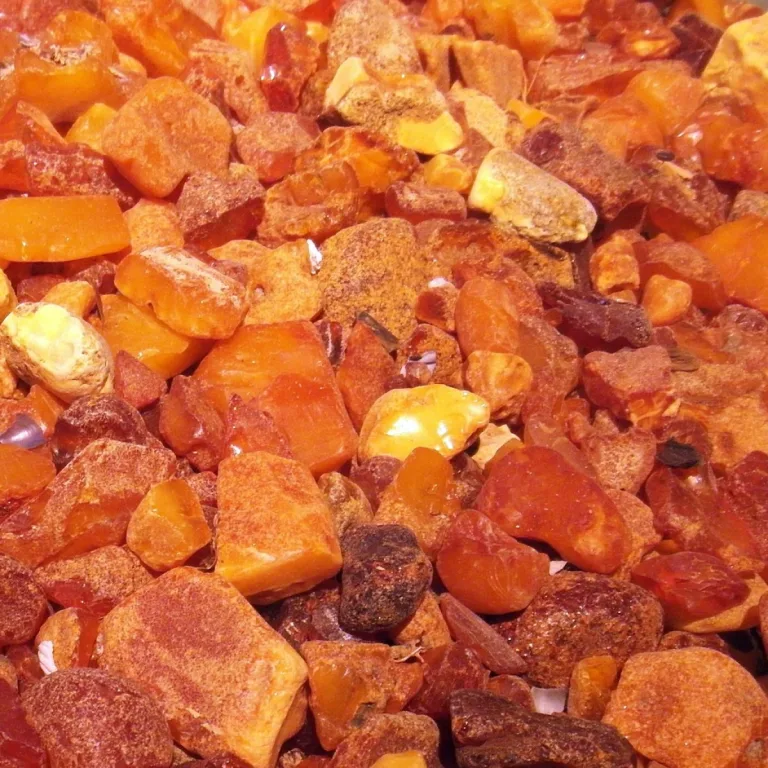It can be difficult to understand that bacteria in our body can be good or even vital for us. But that’s the way it is. Our whole body, especially our intestines are home to a large number of bacteria, which play a very diverse and essential role in our health.
Moreover, good bacteria can even treat some serious diseases.
These good bacteria are called probiotics, which comes from the word “pro-” meaning “for” and “-biotic”, meaning “life” or “for life” as opposed to “antibiotic”, which means “against life”.
Extensive studies have shown that probiotics such as lactic acid-producing bacteria lactobacillus and bifidobacteria are effective in balancing the intestinal microflora.
Human microbiome, also called microflora and microbiota, is a microscopic space that includes thousands of species of bacteria, viruses, and other microbes.
Bacteria live in our gut, mouth, skin, nose and other surfaces, and are one of the fastest growing and most revolutionary areas of research today.
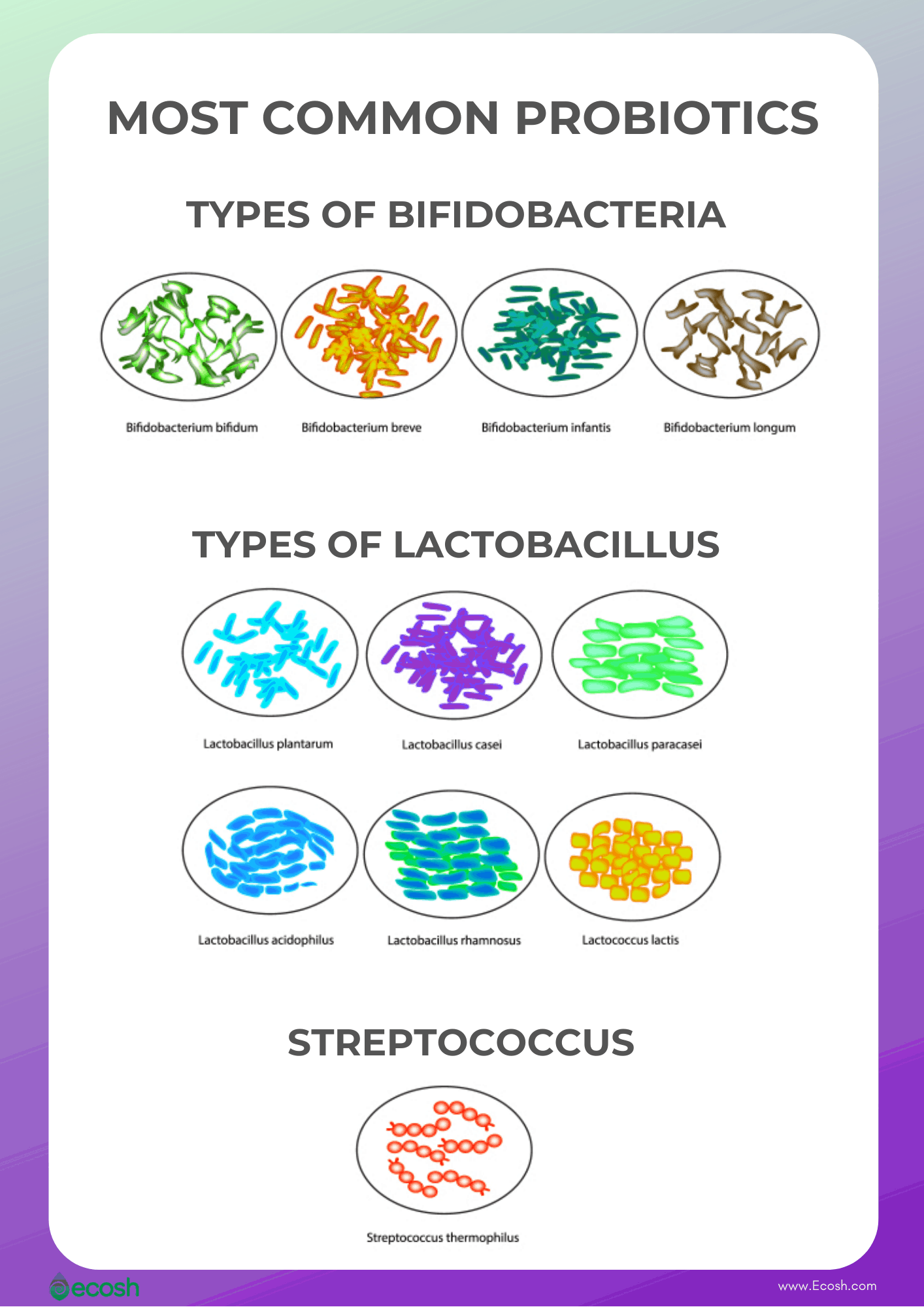
Species of Probiotics
Strains of lactic acid bacteria are the most common microbes engaged as probiotics, especially Lactobacillus and Bifidobacterium species (lactococci, some enterococci and some streptococci are also included as probiotics).
Bifidobacterium is not the traditional Lactic Acid Bacteria. However, the bacterium has a habitat that overlaps with LAB (lactic acid bacteria), and it has a metabolism that produces lactic acid.
These two types of good bacteria Lactobacillus and Bifidobacterium in turn divide into different species:
- Lactobacillus species – Of the more than 100 Lactobacillus species, the following are commonly used probiotics: Lactobacillus acidophilus, Lactobacillus fermentum, Lactobacillus plantarum, Lactobacillus rhamnosus, Lactobacillus paracasei, Lactobacillus gasseri, Lactobacillus reuteri, Lactobacillus salivarius, Lactobacillus helveticus
- Bifidobacterial species – Among 30 species, those recognized as probiotics include:
Bifidobacterium bifidum, Bifidobacterium longum, Bifidobacterium infantis, Bifidobacterium lactis, Bifidobacterium breve, Bifidobacterium adolescentis. - Streptococcus thermophilus

The Gastrointestinal Tract as a World of Intense Activity
The human gastrointestinal tract is up to 10 meters (about 33 feet) long, of which the intestines are about 6-9 meters (20 – 30 feet) long, weighing about 2 kg (about 4 pounds). Each square centimeter of it is densely populated by hundreds of species of bacteria, viruses, fungi, and archaebacteria, totaling about 100 trillion.
During sleep, the good bacteria in your body are mainly involved with multiplying, fighting for food, digesting food, breaking down toxins and releasing by-products such as vitamins, minerals, proteins, fats, antioxidants and anti-inflammatory substances into the blood to nourish and protect the host.
These friendly bacteria break down, for example, sugars, starches and carbohydrates into nutrients so that the body can easily absorb them and convert them into energy.
One of the most important findings is that up to 80% of immune cells are located in the human gut (small and large intestine). It is the good bacteria that protect our immune system, by creating the first line of defense against harmful bacteria such as E. coli bacteria, C. difficile, Helicobacter pylori and against the invasion of other pathogenic microorganisms.
By breaking down and removing toxins, carcinogens, allergens, salts and heavy metals from the body, probiotics prevent the development of various diseases.
Bacteria, the gut and the whole body are so closely linked that, according to the latest research, they even affect our central nervous system, brain, our mood, blood sugar stability and performance in coping with daily life.
For example, stress, depression, difficulty concentrating and anxiety disorders are all related to a disturbed digestive system. So, our health and well-being depend on the condition of our intestines.
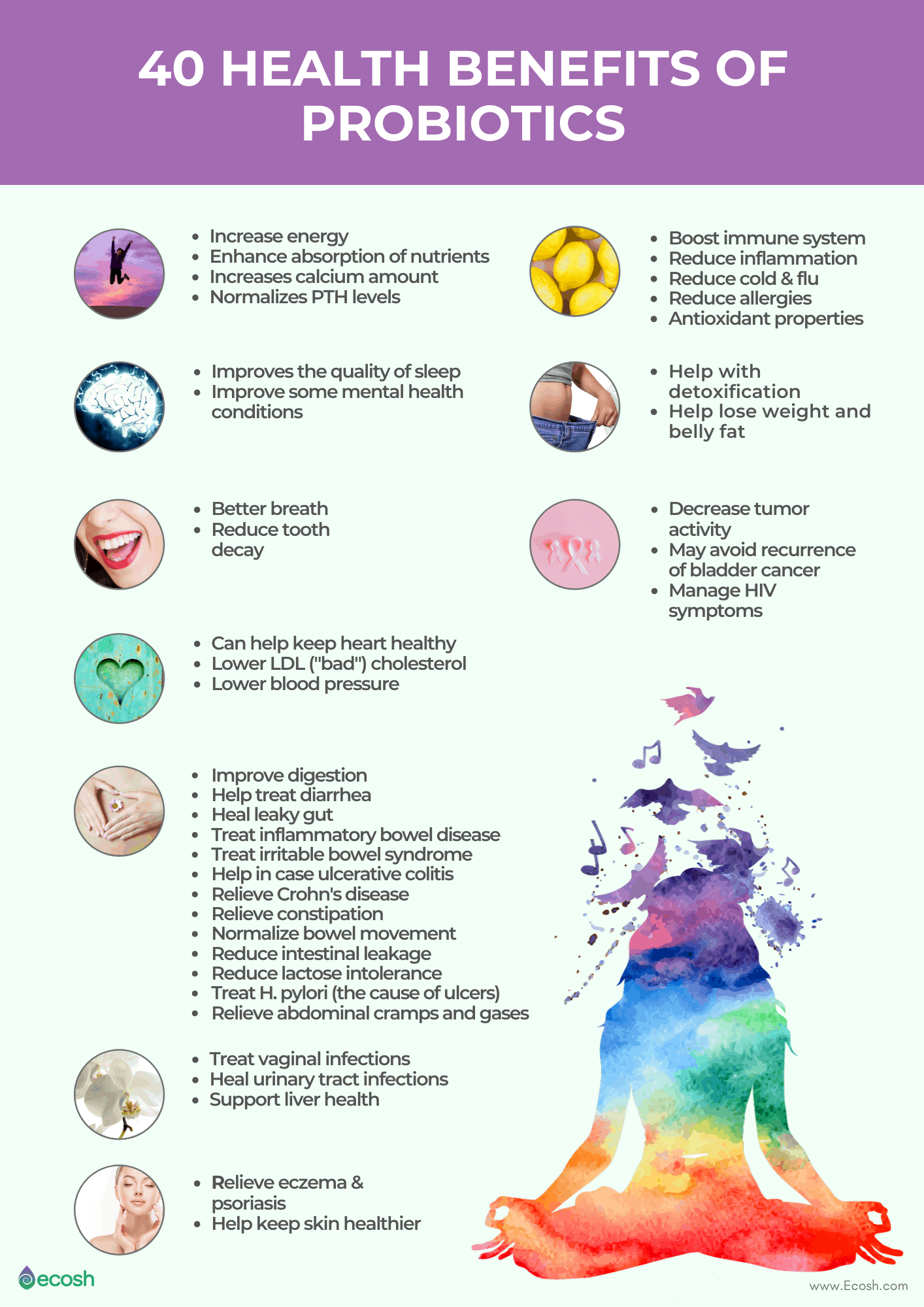
40 Health Benefits of Probiotics
- Strengthen immune system
- Improve digestion
- Help prevent and treat diarrhea
- Increase energy from production of vitamin B12
- Improve some mental health conditions
- Certain probiotic strains may reduce the severity of eczema, psoriasis, and eczema in children
- Reduce allergies
- Better breath because probiotics destroy candida
- Some probiotic strains can help keep heart healthy
- Lower LDL (“bad”) cholesterol and blood pressure
- Help keep skin healthier
- Reduce cold and flu
- Heal leaky gut and inflammatory bowel disease
- Treat irritable bowel syndrome
- Help in case ulcerative colitis
- Relieve Crohn’s disease
- Have antioxidant properties
- Help with detoxification
- Relieve constipation and normalize bowel movement
- Decrease tumor activity
- Reduce intestinal leakage and lactose intolerance
- Treat H. pylori (the cause of ulcers)
- Treat vaginal infections
- Heal urinary tract infections
- May avoid recurrence of bladder cancer
- Treat infection of the digestive tract caused by Clostridium difficile
- Treat pouchitis (a possible side effect of surgery that removes the colon)
- Enhance absorption of nutrients
- Relieve abdominal cramps and gases
- Improve the quality and duration of sleep
- Increase the amount of calcium in the blood
- Normalize PTH levels (associated with bone loss)
- Balance microflora colonization and help avoid dysbiosis
- Help ACE inhibitor production
- Reduce the side effects of antibiotic and chemotherapy treatment
- Support liver health
- Reduce inflammation
- Reduce tooth decay
- Manage HIV symptoms
- Help lose weight and belly fat
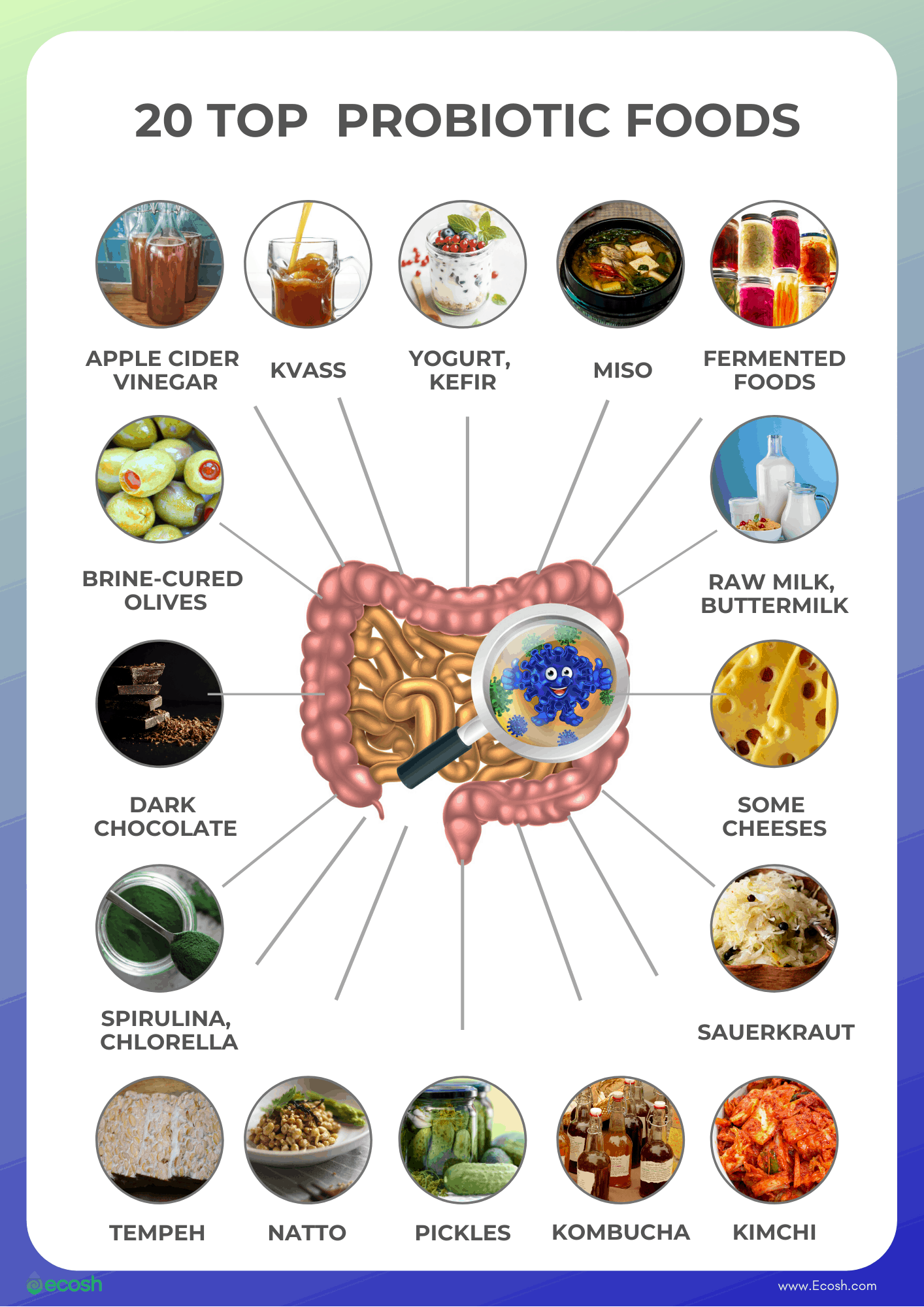
20 Top Probiotic Foods
You can positively support your health and intestinal activity by eating probiotic foods. However, it is important to note that the foods you choose should not be pre-pasteurized, as this will destroy most of the microorganisms that give probiotic foods their effect.
When buying acidified foods, you should prefer a reliable manufacturer, as the use of incorrect methods can lead to the formation of harmful bacteria or microorganisms.
The best probiotic foods are:
- Yogurt
- Kefir
- Coconut kefir – This dairy-free option for kefir has some of the same probiotics as traditional dairy kefir, but is typically not as high in probiotics.
- Water kefir – This beverage is made by adding kefir grains to sugar water, which results in a fermented, fizzy drink that is packed with probiotics.
- Buttermilk
- Raw milk – For example raw cow’s milk, goat’s milk or sheep’s milk.
- Sauerkraut
- Apple cider vinegar
- Pickles and other fermented foods
- Certain types of algae such as spirulina and chlorella.
- Dark chocolate
- Some types of cheeses such as Gouda, mozzarella, cheddar and cottage cheese, because the good bacteria survive the aging process in these.
- Goat’s milk, sheep’s milk and A2 cow’s soft cheeses are particularly high in probiotics, including thermophillus, bifidus, bulgaricus and acidophilus.
- Miso
- Tempeh (fermented soy product).
- Natto (fermented soybeans).
- Kimchi, an Asian spicy sauerkraut.
- Kombucha, a fermented drink made from black and green tea.
- Kvass – A common fermented beverage in Eastern Europe since ancient times, which is traditionally made by fermenting rye or barley.
- Brine-cured olives – Make sure that your olives don’t contain sodium benzoate, a food additive that can negate many of the health-promoting properties of this probiotic power-food.
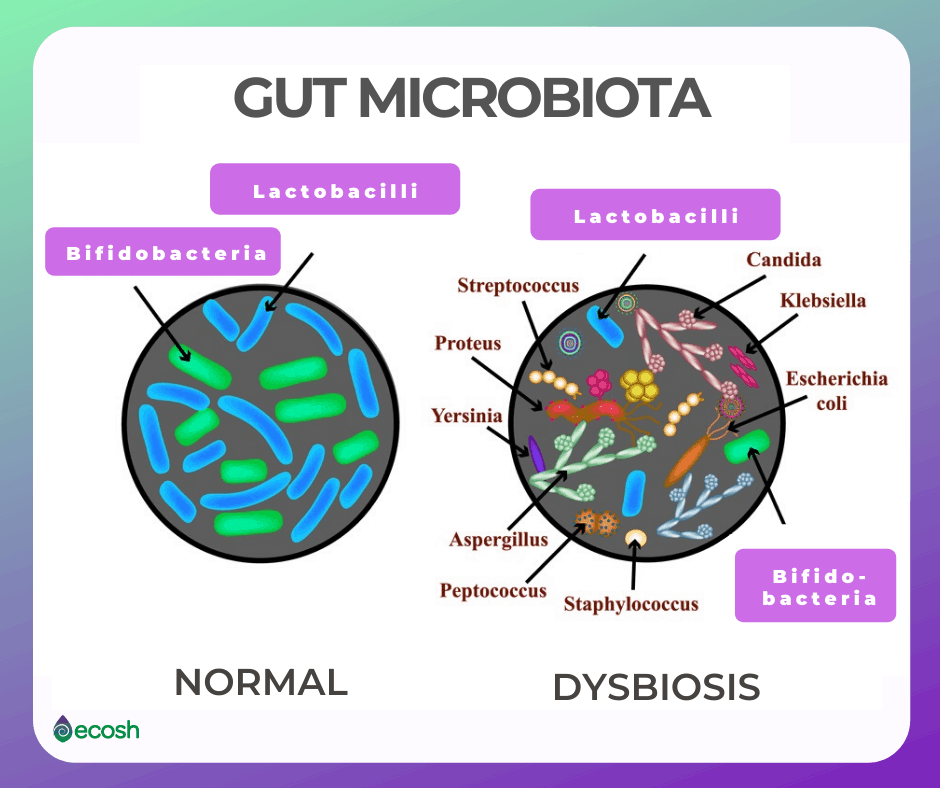
Probiotic Food Supplements
Sour milk or kefir made from pure and natural unpasteurized milk is often difficult to find. However, an alternative is to administer human-specific probiotic lactic acid bacteria from the jar to increase the proportion of beneficial bacteria in the intestinal microflora.
You should also consider taking probiotics if you have consumed antibiotics or are suffering from a long-term health problem (such as indigestion, candidiasis, high cholesterol, eczema, allergies).
In this case, it may not be beneficial to eat only acidified foods, as depending on the storage and the quality of processing, the foods may not contain a sufficient number of viable bacteria.
Although there are hundreds of bacterial strains in the gut, it is important that the probiotics contain those strains that are compatible with each other and can interact with other bacteria when they reach the gut.
Probiotics, Which Ones to Consume?
As most probiotics are sold as dietary supplements, they do not undergo the testing and approval process that drugs do. So, manufacturers themselves are responsible for making sure they’re safe before they’re marketed and that any claims made on the label are true.
But there’s no guarantee that the types of bacteria listed on a label are effective for the condition you’re taking them for.
Not all strains are necessarily helpful for you because the benefits of probiotics depend on the specific strain. Therefore you may want to ask advice from a doctor who knows more about the probiotics. You can also read about the health benefits of the different strains of probiotics in our previous article here.
Maria-Helena Loik
Sources: Draxe.com, Healthline.com, Health.harvard.edu
Pictures: Pexels.com, Pixabay.com, Shutterstock.com, Kisspng.com

